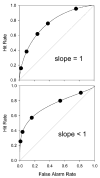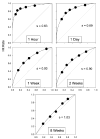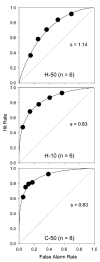The hippocampus supports both the recollection and the familiarity components of recognition memory
- PMID: 16446148
- PMCID: PMC1457095
- DOI: 10.1016/j.neuron.2005.12.020
The hippocampus supports both the recollection and the familiarity components of recognition memory
Abstract
The receiver operating characteristic (ROC) has been used to investigate the component processes of recognition memory. Some studies with this technique have been taken to indicate that the hippocampus selectively supports the process of recollection, whereas adjacent cortex in the parahippocampal gyrus supports the process of familiarity. We analyzed ROC data from young adults, memory-impaired patients with limited hippocampal lesions, and age-matched controls. The shape of the ROC changed in similar ways from asymmetric to symmetric, as a function of the strength of memory (strong to weak) in both the young adults and the patients. Moreover, once overall memory strength was similar, the shape of the patient ROC was asymmetric and matched the control ROC. These results suggest that the component processes that determine the shape of the ROC are operative in the absence of the hippocampus, and they argue against the idea that the hippocampus selectively supports the recollection process.
Figures





Similar articles
-
Selective disruption of hippocampus-mediated recognition memory processes after episodes of transient global amnesia.Neuropsychologia. 2009 Jan;47(1):70-6. doi: 10.1016/j.neuropsychologia.2008.08.019. Epub 2008 Aug 22. Neuropsychologia. 2009. PMID: 18789957
-
Recollection and familiarity in hippocampal amnesia.Hippocampus. 2008;18(5):469-80. doi: 10.1002/hipo.20412. Hippocampus. 2008. PMID: 18306303
-
Recollection and familiarity in dense hippocampal amnesia: a case study.Neuropsychologia. 2006;44(3):489-506. doi: 10.1016/j.neuropsychologia.2005.05.014. Epub 2005 Jul 14. Neuropsychologia. 2006. PMID: 16023686
-
ROC in animals: uncovering the neural substrates of recollection and familiarity in episodic recognition memory.Conscious Cogn. 2010 Sep;19(3):816-28. doi: 10.1016/j.concog.2010.06.023. Epub 2010 Aug 5. Conscious Cogn. 2010. PMID: 20691613 Free PMC article. Review.
-
The role of the human hippocampus in familiarity-based and recollection-based recognition memory.Behav Brain Res. 2010 Dec 31;215(2):197-208. doi: 10.1016/j.bbr.2010.04.020. Epub 2010 Apr 20. Behav Brain Res. 2010. PMID: 20412819 Free PMC article. Review.
Cited by
-
Recollection and familiarity: examining controversial assumptions and new directions.Hippocampus. 2010 Nov;20(11):1178-94. doi: 10.1002/hipo.20864. Hippocampus. 2010. PMID: 20848606 Free PMC article. Review.
-
Recognition memory: opposite effects of hippocampal damage on recollection and familiarity.Nat Neurosci. 2008 Jan;11(1):16-8. doi: 10.1038/nn2016. Epub 2007 Nov 25. Nat Neurosci. 2008. PMID: 18037884 Free PMC article.
-
Dissociation between recognition and recall in developmental amnesia.Neuropsychologia. 2009 Sep;47(11):2207-10. doi: 10.1016/j.neuropsychologia.2009.01.038. Epub 2009 Feb 5. Neuropsychologia. 2009. PMID: 19524088 Free PMC article.
-
Neural correlates of familiarity-based associative retrieval.Neuropsychologia. 2010 Aug;48(10):3019-25. doi: 10.1016/j.neuropsychologia.2010.06.010. Epub 2010 Jun 12. Neuropsychologia. 2010. PMID: 20547169 Free PMC article.
-
When false recognition is out of control: the case of facial conjunctions.Mem Cognit. 2009 Mar;37(2):143-57. doi: 10.3758/MC.37.2.143. Mem Cognit. 2009. PMID: 19223564
References
-
- Aggleton JP, Vann SD, Denby C, Dix S, Mayes AR, Roberts N, Yonelinas AP. Sparing of the familiarity component of recognition memory in a patient with hippocampal pathology. Neuropsychologia. 2005;43:1810–1823. - PubMed
-
- Barbeau E, Felician O, Joubert S, Sontheimer A, Ceccaldi M, Poncet M. Preserved visual recognition memory without the hippocampus: evidence from a case study. Hippocampus. 2005;15:587–596. - PubMed
-
- Bastin Ch, Van der Linden M, Charnallet A, Denby Ch, Montaldi D, Roberts N, Mayes A. Dissociation between recall and recognition memory performance in an amnesic patient with hippocampal damage following carbon monoxide poisoning. Neurocase. 2004;10:330–344. - PubMed
-
- Brown MW, Aggleton JP. Recognition memory: what are the roles of the perirhinal cortex and hippocampus? Nat Rev Neurosci. 2001;2:51–61. - PubMed
Publication types
MeSH terms
Grants and funding
LinkOut - more resources
Full Text Sources
Other Literature Sources

